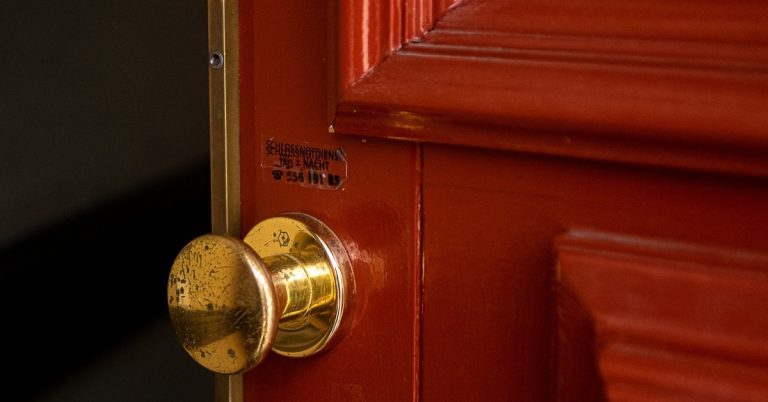
The beauty and elegance of antique brass doorknobs are unmistakable. The fact that door handles play a role in the transmission of numerous illnesses is cause for worry. Some materials, such as brass, copper, and silver, are deadly to many bacteria over time.
Although the actual process is unknown, it is often assumed to be due to the oligodynamic effect or another electrostatic action.
Within eight hours, brass and copper, for example, have disinfected themselves of numerous pathogens.
Doorknobs and Disinfection
Doorknobs are one of the most often touched surfaces in the home, yet we rarely remember to clean them when we’re doing the rest of our tasks. When you wipe out a doorknob, you might be amazed at how much dirt comes off – even if it appears to be spotless. Apart from bacteria, the oils on our hands collect on these microscopic surfaces over time, drawing even more filth.
If you’re concerned about bacteria, consider the following: Brass and copper doorknobs really inhibit the growth of microorganisms. Metal ions in brass and copper have a harmful impact on moulds, spores, viruses, and other living organisms, which is known as the oligodynamic effect.
[lead-form form-id=1 title=Fill to Get Free Cleaning Checklist]
You may also like to read : What is a cleaning chemical ?

Brass Doorknobs
Brass doorknobs that haven’t been polished miraculously sanitise themselves in around eight hours. If your knobs are made of a different material, such as stainless steel or glass, be aware that these non-self-cleaning surfaces might be a breeding ground for germs, with some microbes surviving for over a month. If someone in your family has a cold, sanitise all of the doorknobs they come into touch with.
Spray the area with vinegar and wipe dry with a clean towel for a natural, non-toxic cleaning method. Concentrate on the knobs and handles that get the most use throughout the day, such as the front door, bathroom doors, refrigerator doors, and even the small knobs on your kitchen cabinet doors.
The flu season may have passed us by, but we’re not out of the woods yet. To avoid the transmission of sickness, it’s important to stay attentive with cleaning and disinfecting around the house all year. What’s the first line of defence for you? Keep up with cleaning high-traffic areas like light switches and doorknobs, which are breeding grounds for germs and viruses that may survive for up to a week on hard surfaces.
But, before you go out and buy more disinfectants, have a look at your hardware: While bacteria thrive in aluminium and stainless steel, studies suggest that brass, copper, and silver have self-sterilizing properties. It isn’t magic; rather, it is science. The oligodynamic effect is what it’s termed.
What is the Oligodynamic Effect and How Does It Work?

The Swiss Karl Wilhelm von Nägeli identified the oligodynamic effect in 1893 as a harmful impact of metal ions on live cells, algae, moulds, spores, fungus, viruses, and microbes, even at low concentrations. Ions of brass, silver, copper, iron, lead, zinc, gold, aluminium and other metals have antibacterial properties.
Glass, porcelain, stainless steel, and aluminium, on the other hand, do not have this impact.
Essentially, oligodynamic metals are metals that contain ions that kill living cells such as bacteria, fungus, spores, and viruses. Remember learning about affinities in biology class in high school?
Germs have an affinity for silver, copper, and brass metallic ions, which means the bad guys might be mostly gone in as little as 15 minutes. If you have unpainted brass doorknobs or cabinet handles, for example, they’re naturally fighting germs for you around the clock.
In 4 hours, copper will destroy several common germs. Because brass is an alloy, it takes a little longer. Some bacteria take longer than 4 hours to die on copper, however, the majority of germs are dead after 12 hours. Because stainless steel lacks copper and silver, it takes 5 times longer. The copper ions can’t get into the bacterium if the air is dry, thus it’s ineffective.
There’s more good news: it’s not just your doorknobs that are affected. Other things in your house, like copper pots and silver cutlery, maybe self-sanitized in the same way. A copper kettle destroyed salmonella bacteria in drinking water in four hours in one research, but silver took roughly twice as long. Keep in mind that the majority of current “silver” forks and spoons are really steel, which has no miraculous germ-killing properties.
You may also like to read : How to do metal cleaning

Copper has proven its effectiveness against a range of hazardous germs. Testing has demonstrated that it not only combats superbugs such as MRSA and C. Difficile but also targets other harmful pathogens like the influenza virus and E. Coli. These findings highlight copper’s potential as a powerful antimicrobial agent in fighting various dangerous microorganisms.
How Do Copper Ions Degrade Bacterial DNA and Inhibit Respiration?
Copper ions are remarkably effective at battling bacteria through two main actions—one direct and one indirect.
Direct Impact on DNA
Copper ions directly interfere with bacterial cells by targeting and degrading their DNA. This degradation compromises the cell’s structural integrity and interrupts its ability to replicate or function normally. The breakdown in DNA means the bacteria can’t carry out essential processes, eventually leading to its demise.
Indirect Action on Respiration
The indirect mechanism kicks in on dry surfaces. Here, copper doesn’t just attack the cell directly. It interacts with the bacteria’s metabolism, leading to the formation of free radicals, which are highly reactive molecules. These free radicals are even more aggressive than the copper ions themselves in destroying DNA and shutting down the cell’s respiration. Without the ability to respire, the bacterial cells quickly lose viability.
In summary, copper ions play a dual role in decimating bacteria by both degrading DNA directly and indirectly generating destructive free radicals.
Uncovering Copper’s Impact on Bacteria: Direct and Indirect Effects
Copper wields a powerful influence over bacteria through two main mechanisms: direct and indirect.
Direct Effects: The release of copper ions directly targets the DNA within bacterial cells. This action not only degrades their DNA but also hampers their ability to breathe, effectively stifling their function and growth.
Indirect Effects: On dry surfaces, copper goes a step further. It interacts with the bacteria’s metabolic processes to produce highly reactive free radicals. These free radicals are exceptionally efficient, acting even faster than the copper ions themselves to break down DNA and disrupt cellular respiration.
In summary, copper’s dual action—both through ion release and free radical generation—proves to be a formidable opponent to bacterial life.

Researchers conducted an experiment to test bacterial growth on different door handle materials. They compared two types of metal: stainless steel and copper. Each surface was coated with 10 million MRSA cells to observe how the bacteria would thrive on these commonly used door handle materials.
More about metal’s disinfectant properties:
- Copper has been shown to totally eradicate mould in as little as six hours, and its cleansing qualities can start working as soon as 15 minutes after contact.
- Silver is often used for water storage, such as in airline water tanks since it can disinfect bacteria cells in water in as little as 12 hours.
- Bacteria may live for up to 30 days on stainless steel, the most commonly used material for hospital and food processing equipment.



